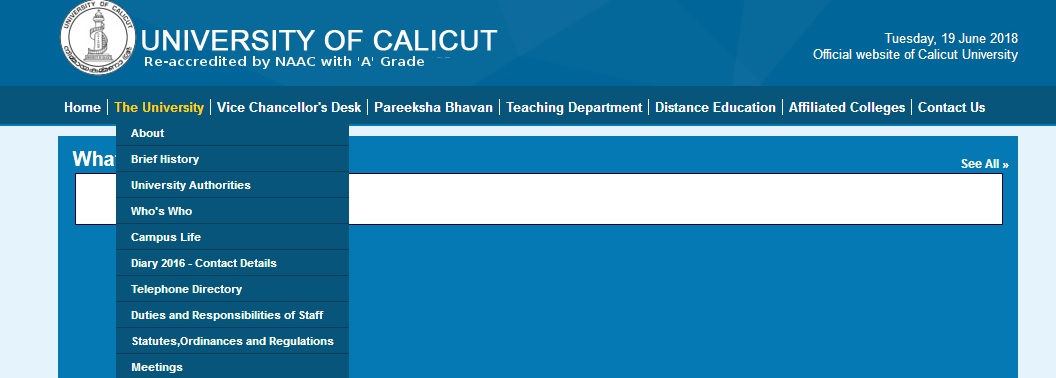universityofcalicut.info B.Sc Microbiology Question Paper Model : University of Calicut
Name of the University : University of Calicut
Degree : BSc
Name Of The Subject : Microbiology
Document type : Model Question Paper
Website : universityofcalicut.info
Download Model Question Paper: https://www.pdfquestion.in/uploads/7558-Microbio.pdf
University of Calicut Microbiology Question Paper
Time : 3 hrs
I. Answer all questions : Choose the correct answer
1. Weil’s disease is caused by,
a) Leptospira interrogans (b) Leptospira biflexa (c) Leptospira icterohaemorrhagiae (d)
Treponema vincentii
Related / Similar Question Paper :
University of Calicut BA Population & Society Question Paper
2. An example for a Differential medium,
a) Nutrient agar (b)Mac Conkey’s agar (c) Chocolate agar (d) Tellurite agar
3. Modified Thayer -Martin medium is a selective medium used for ,
a)Neisseria (b) Clostridium (c) Pneumococcus (d) Brucella.
4. The shape and position of the spore in Cl. etani is,
a) oval and terminal (b) spherical and terminal (c) central and oval (d) central and spherical.

Write True or False :
5. Hepatitis A Virus is an enveloped virus.
6. Rocky Mountain Spotted Fever is transmitted by Flea.
7. Malchite green in the Lowenstein-Jenson medium is a selective agent.
8. Streptococcus is Catalase positive while Staphylococcus is negative.
Answer in one word:
9. Name a fungus infection of hair.
10. Which is the receptor host cell in HIV infection?
11. Name a pathogenic yeast-like fungi.
12. Which is the famous serological test for the diagnosis of Enteric Fever
II. Comment briefly on all the following:
13. Negri bodies
14. Rubella
15. Septicemia
16. Weil’s disease
17. Nosocomial infection
18. Plasmodium falciparum
19. Pandemic
20. Paradoxical carrier
III. Write short essay on any 5 of the following:
22. Subcutaneous mycoses
23. Type B Hepatitis
24. Kirby-Bauer test
25. Laboratory diagnosis of diphtheria
26. Rickettsial diseases
27. Varicella
28. Filariasis
IV. Answer any 2 of the following:
29. Explain the different methods of transmission of infection with suitable example
30. Discuss the epidemiology and laboratory diagnosis of syphilis
31. Explain pulmonary tuberculosis. Add a note on its treatment.
Code No : MB2C03.
Microbial Metabolism & Genetics
1. Enzymes-characteristics and properties of enzyme, nomenclature, mechanism of enzyme action, factors influencing enzyme activity, inhibition of enzyme action.
2. Metabolism-Energy production-aerobic and anaerobic process. Respiration, Glycolysis, TCA-cycle, pentose phosphate pathway, Fermentation, Brief account of catabolism of carbohydrates, lipids, proteins and amino acids Photosynthesisbacterial and cyanobacterial.
3. Structure and functions of genetic material, DNA and chromosome, RNA structure, Genetic code, Regulation of gene expression-repression, induction, attenuation. Mutation-types of mutation, replica plating, Ames test .
4. Gene transfer methods –transformation, conjugation, transduction. Plasmids, transposons, Restriction and modification of DNA, Recombinant DNA. Expression of foreign genes, Application of genetic engineering.
Code No : MB2C04 (P)
Microbiology Practical II
1. Preparation buffers.
2. Protein Estimation using Lowry’s method
3. Folin – Ciocalteau estimation of unknown protein using Std. graph
4. Carbohydrate estimation
5. Estimation of ascorbic acid in plant matter
6. Paper chromatography
7. TLC
8. Column separation of plant pigments
9. Demonstration of mitosis and meiosis.
10. Extraction and estimation of DNA.
11. Electrophoresis.
12. Preparation of gradient solutions.
13. Separation of plant pigments
Code No : MB4C07.
Medical Microbiology & Immunology
1. Types of infection, Source of infection, Modes of transmission, Bacterial diseases caused by –Staphylococcus aureus, Mycobacterium tuberculosis, Clostridium tetani, Clostridium botulinum, Vibrio cholerae, Salmonella typhi.
2. Viral diseases – Rabies, AIDS, Hepatitis, Rubella, Fungal diseases- Candidiasis, Ringworm, Protozoan diseases- Amoebiasis, Malaria .
3. Types of immunity-innate and acquired, Hematopoiesis, Cells and organs of immune system, humoral and cell mediated immunity.
4. Antigens-types, epitopes, haptens, Basic structure of immunoglobulin, IgG, Polyclonal and monoclonal antibodies, clonal selection theory, Antigen – antibody reactions-agglutination and precipitation reactions, complement pathways, immunological tolerance in brief. 6
5. Hypersensitivity and its types, autoimmune diseases- different types and its mechanisms.
Code No. : MB4C08 (P).
Microbiology Practical IV
1. Differential count of leukocytes.
2. Lymphocyte isolation.
3. Blood grouping.
4. WIDAL agglutination test.
5. RPR test.
6. AFB staining.
7. Biochemical reactions for identification of various groups of bacteria.
8. Antibiotic sensitivity test.
of soil organisms, Rhizosphere
and rhizosphere effect, Interaction among soil microorganisms-positive, neutral,
negative associations, Role of microorganisms in biogeochemical cycles-Carbon
and nitrogen. Nitrogen fixation.
5
3. Water Microbiology: Factors affecting microbial population in natural waters –
temperature, light, hydrogen concentration, pressure, salinity, nutrients, turbidity,
Microbiology of drinking water. Purification of water-aeration, sedimentation,
coagulation, flocculation, sand filtration . Disinfection of drinking waterchemical
and physical. Indicator organisms, bacteriological techniques for
examination of water.
Calculate
Initial level of glucose is =2247 mg per 10 ml
Final level of glucose is =3045 mg per 10 ml
Amount of alcohol produce is=725 mg per 15 ml
Please solve.